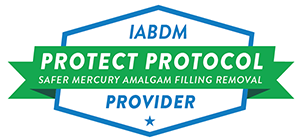Breath Freely: The Importance of Airway Health

As humans have evolved, significant changes in diet and lifestyle have impacted our airway health. Modern diets, eating practices, and daily habits have influenced the development of our jaws, teeth, and sinuses, often leading to various health issues. Airway dentistry has emerged as an important field to address these challenges, utilizing innovative treatments such as the DNA appliance, clear aligners, pediatric expanders, and NightLase procedures. In this article, we will discuss the power of airway dentistry and why we practice it here at enlightenDENTAL.
History of Human Airway Health
Human development has seen a dramatic shift from the days of our ancestors, who consumed hard, fibrous foods that required lots of chewing. This intense chewing activity was essential for developing strong jaws and well-aligned teeth. However, with the advent of agriculture and processed foods, our diets have become considerably softer. The reduced need for chewing has led to underdeveloped jaws, crowded teeth, and misaligned bites, all of which can compromise airway health.
Aside from dietary changes, eating practices have also evolved. Historically, prolonged breastfeeding was common, which results in proper jaw development and nasal breathing due to the effort required to latch. While now in modern days bottle feeding and the early introduction of soft, solid foods, do not provide the same developmental benefits. This shift has resulted in narrower dental arches and improper tongue positioning, contributing to constricted airways.
The Evolution of the Human Face and the Impact of Modern Orthodontic Practices
A few hundred years ago, the human face was markedly different from what it is today. With a forward-grown structure, a wide profile, and large dental arches, people of the past had straight teeth and ample space for their tongues. This facial structure also provided plenty of space behind the upper jaw, facilitating easy nasal breathing.
However, the modern face has undergone significant changes. From childhood, many individuals now have less developed dental arches, leading to crowded teeth and restricted space for the tongue, which impacts the airway. Several factors contribute to these changes, including allergies that affect breathing, poor nutrition, and the softness of modern diets. These issues result in underdeveloped chewing muscles and smaller dental arches in toddlers. Consequently, the upper jaw often develops too far back, making normal nasal breathing difficult.
To compensate for the lack of nasal airflow, children may start mouth breathing, which involves opening the mouth and bringing the lower jaw down and back. This adaptation creates a downward swing of the face and can give the appearance of buck teeth, although the individual is actually compensating to breathe properly. If not addressed, this problem can persist into adulthood.
Historically, extractions were documented in the 1600s as a quick fix for dental crowding. While effective in the short term, they did not address the underlying issue of underdeveloped arches and often negatively impacted the facial profile. This approach remains controversial even today. In the 1800s, orthodontists who favored extractions sought more effective ways to retract teeth, leading to the development of headgear and retractive orthodontics. They mistakenly believed that in children with buck teeth, the upper jaw was overgrown. They thought that by restraining its growth with headgear, the lower jaw would catch up, aligning the teeth. Despite studies throughout the 1900s disproving this theory, the myth became a foundation of conventional orthodontics.
Research has shown that headgear and retractive orthodontics suppresses the growth of both jaws, causing them to grow down and back into the airway, resulting in a clockwise rotation of the lower third of the face. This deformation, known as the headgear effect, continues into adulthood. To breathe, individuals may adopt a forward head posture, which can lead to a lifetime of neck and back pain. This posture is an infamous consequence of the growth-stunting forces of headgear, which pass through the skull and cause abnormal rotations of the sphenoid bone. No studies have thoroughly examined the long-term impact of headgear on skeletal blood flow and nerve pathways in growing children.
Airway and TMJ: The Importance of Nasal Breathing on Jaw Health
During nasal breathing, the tongue rests against the palate, providing a balance against the pressure from the cheeks. This balance is important for maintaining the proper shape of the upper jaw. Without this balance, the upper jaw can deform into a V-shaped arch instead of the correct U-shaped arch. This deformation disrupts normal swallowing function, as the tongue then presses against the lateral teeth during swallowing, leading to a lateral tongue thrust and hindering proper tooth eruption.
An incorrect lower jaw position can trigger parafunctional activities such as clenching and grinding of the teeth. Over time, grinding can significantly wear down the teeth, causing them to shorten and the lower jaw to shift even further distally. This decreases the vertical dimension of the bite, which can eventually lead to joint degeneration, deformation of the TMJ, even less room for the tongue, and damage to the joint's ligaments. As a result, the TMJ disc may become trapped in front of the condyle, leading to limited mouth opening, a cessation of the clicking sound, and a further restricted airway.
To learn more about the imp of nasal breathing on jaw health, watch this video: Airway and TMJ Vivos Utah
The Consequences for Jaw and Sinus Development
These evolutionary changes have led to smaller jaw sizes, which in turn cause dental crowding and misalignment. Furthermore, inadequate jaw growth affects the sinus cavities, often resulting in narrower airways. This can lead to a higher incidence of breathing issues such as sleep apnea, which significantly impacts overall health and quality of life.
Adequate sleep is essential for maintaining optimal airway function, and disruptions in sleep patterns can have significant consequences for respiratory health.
One of the key ways in which sleep influences airway health is through its effect on muscle tone and relaxation. During sleep, the muscles around the airway naturally relax to facilitate breathing. However, inadequate or disrupted sleep can lead to increased muscle tension in the throat and airway, potentially causing airway obstruction and breathing difficulties.
For more information about the importance of sleep: What Happens To Your Body And Brain If You Don't Get Sleep | The Human Body
How We Address Airway Issues
In modern dentistry, addressing airway issues and the alignment of teeth has become increasingly important due to the significant impact these factors have on overall health. At our practice, we utilize a range of advanced solutions, including home sleep tests, pediatric expanders, the Vivos appliance, NightLase® therapy, and Candid aligners to address these issues effectively.
Home Sleep Test- The First Step

A home sleep test is a convenient and effective way to diagnose sleep disorders such as obstructive sleep apnea (OSA). This test monitors various physiological parameters while the patient sleeps in their own bed, providing accurate data about their breathing patterns, oxygen levels, and heart rate. The results help in diagnosing the presence and severity of sleep apnea, which can then be treated with appropriate interventions.
Pediatric Expanders

Palatal expanders are orthodontic devices used to widen the upper and lower jaw, creating more space in the mouth. This is particularly beneficial for children whose dental arches are underdeveloped, leading to crowded teeth and restricted airways. By gradually expanding the palate, these devices not only help in aligning the teeth properly but also improve nasal breathing. This early intervention can prevent more severe orthodontic issues and airway problems later in life.
Vivos Appliance

The Vivos appliance offers a non-surgical solution designed to address underdeveloped jaws. By remodeling and repositioning the jaw, it enhances airway function. This innovative device works by expanding the dental arches and repositioning the jaws, which can improve the airway. While the primary focus is on jaw development, some patients may experience relief from symptoms associated with sleep-disordered breathing, such as obstructive sleep apnea (OSA). The Vivos system is tailored to each patient, ensuring optimal results without the need for invasive procedures.
NightLase® Therapy

NightLase® is a laser treatment designed to reduce snoring and alleviate symptoms of sleep-disordered breathing. This non-invasive procedure uses laser energy to gently heat the tissues of the airway, stimulating collagen production and causing the tissues to tighten and retract. The result is a reduction in airway obstruction, leading to better breathing and less snoring during sleep. NightLase therapy is a painless, quick, and effective solution that typically involves a series of appointments, depending on the severity of the sleep-disordered breathing.
Candid Aligners

Candid aligners are clear, BPA- free removable orthodontic devices used to straighten teeth discreetly and comfortably. These aligners are custom-made for each patient and gradually move teeth into their correct positions utilizing an expansive technique. Unlike traditional braces, Candid aligners are nearly invisible and can be removed for eating and cleaning, offering a convenient and aesthetically pleasing solution for correcting dental misalignments. Proper alignment and the expansion of the dental arches can also improve airway function and overall oral health.
Myofunctional Therapy

Myofunctional therapy is a therapeutic approach focused on retraining the muscles of the tongue to improve breathing and reduce airway obstructions. This non-invasive treatment involves a series of exercises targeting the orofacial muscles, including the tongue, lips, cheeks, and throat. By strengthening these muscles and promoting proper oral posture, myofunctional therapy helps keep the airway open, reducing the risk of sleep-disordered breathing issues such as obstructive sleep apnea (OSA).
Conclusion
Airway dentistry is a root cause-based approach that focuses on diagnosing and treating the underlying issues affecting oral and overall health, particularly those related to airway function. While immediate concerns such as cavities and other dental problems often require prompt attention, airway dentistry emphasizes the importance of maintaining optimal airway health. Proper airway function supports a healthy oral microbiome, which can prevent the development of further dental and systemic health issues. By addressing the root causes of airway dysfunction, such as structural abnormalities or improper oral habits, airway dentistry aims to promote long-term health and well-being, reducing the need for future interventions.
At enlightenDENTAL, we are committed to addressing airway and orthodontic issues with the most advanced and effective solutions available. By utilizing home sleep tests, pediatric expanders, the Vivos appliance, NightLase® therapy, and Candid aligners, or a combination of these therapies, we provide comprehensive care tailored to the unique needs of each patient. These interventions not only improve dental and airway health but also enhance overall well-being. If you or your child are experiencing issues related to sleep apnea, dental crowding, or misalignment, we encourage you to explore these innovative treatment options with us!



.png)


